The Roman army strikes us with the imagination of hand-to-hand and heavy infantry, but it was a lot more complicated than that. The Romans adapted to any strategic and tactical situation, and it did use auxiliaries, which means mercenaries.
Armed with various kinds of ancient and medieval weapons, the Roman army fortified its reign even in the Western part of the world.
Along with their sharp wits, they tamed the barbarians with these mercenaries and expanded their territories to the British Isles, Near East, and North Africa. Initially expounded on the Greek and Etruscan models, they advanced to the Celtic and the Carthaginian models.
While there were numerous others, the Gladius, the Pugio, and the pilum were the primary arms. For today’s article, I am concisely writing about the ancient Roman weapons of war.
10. Sling
Content
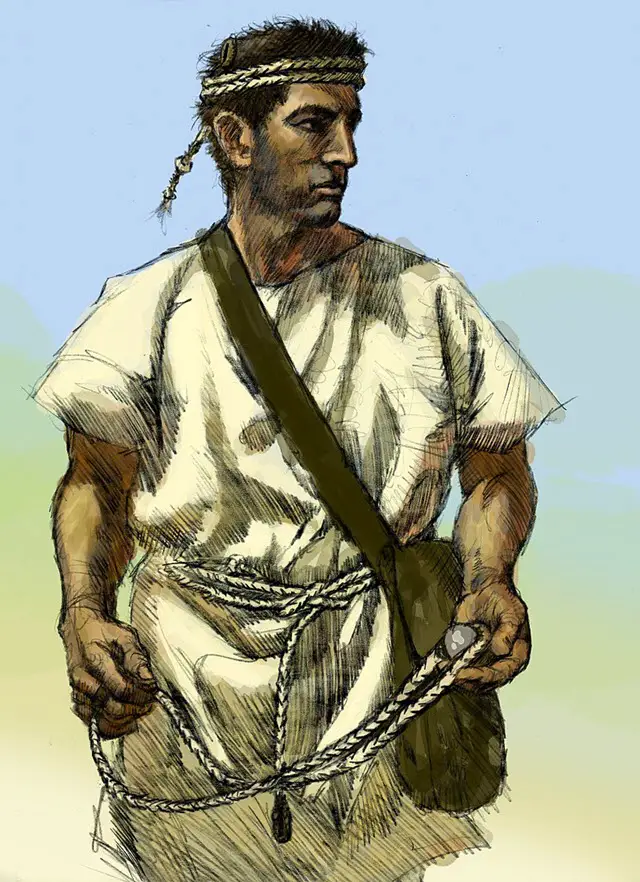
Wikimedia Common
The slingers were recruited directly from the Balearic island. They are an archipelago chain found off the east coast of Spain. The inhabitants often used slings for hunting animals or protecting their herds. Indeed, Balearic’s name comes from the Greek verb ‘balo,’ meaning ‘to throw.’
Of course, the idea of a sling is not that complicated. You take a stone and put it in a pouch, and you swing it, and you’ll hit someone, possibly who was not too far away from you. But accuracy required training; not everyone could do that and be significant from a military perspective.
So can a stone, thrown with a sling, in the Classical period kill a man? Well, the answer is yes. Had the man wearing a helmet, it’d be more difficult but plausible. As we look at the Trajan column, we see that the slingers are dangling from the Roman figures’ hands.
The sling is also the humble counterpart of archery (bow and arrow). It can lose lead bullets at speeds of over 100 kilometers per hour and ranges of up to 400 meters. It was the king of ranged combat, which dominated the battlefield until the advent of the crossbow and gunpowder weaponry.
9. Lorica Segmentata
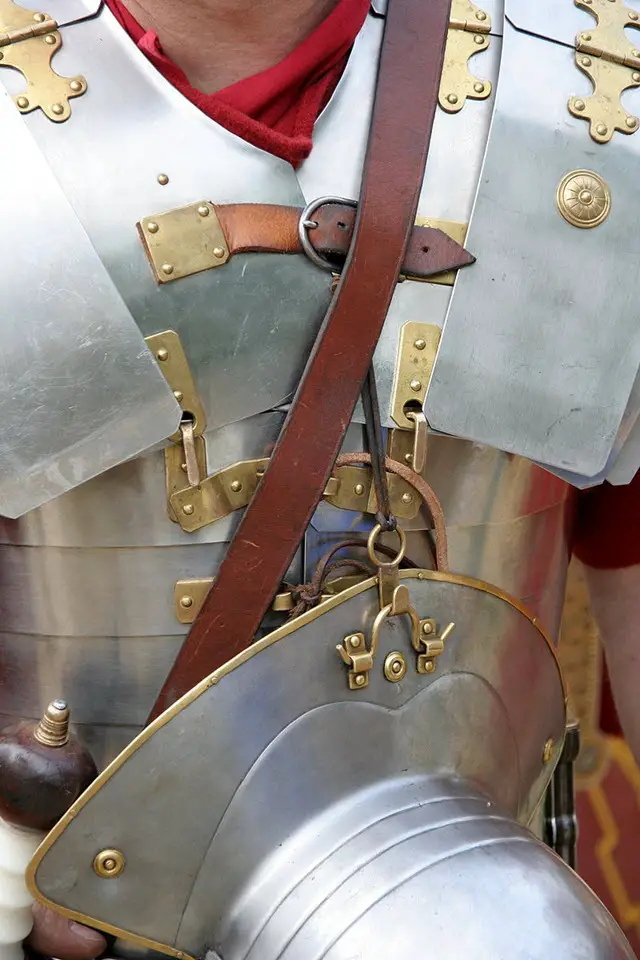
Wikimedia Common
The Lorica Segmentata is a type of Roman armour of war used between the first century and the third century AD. It is an iconic body shield that can be recognized from afar.
Back when Rome was still under Kings, the Roman infantry was spear-based. Later somewhere in the third century, it changed to sword-based infantry. The more affluent class could afford what was called lorica hamata, while the poor had a square or a circle of metal covering the center of their chest. The Celts of Southeastern Europe invented the lorica hamata. It provided great defense against cutting strokes, but it was costlier.
They started using plate armor around the first century AD, which is effectively what lorica segmentata is. We do not know what the Romans originally called it. There is also a debate regarding its material-whether it was steel or iron.
The best feature of a segmentata is that any chopping or slashing blow cannot penetrate through you. It was one of the most fundamental reasons for choosing segmentata over hamata (chain mail) or Squamata (scales sewn atop a leather vest). Thus, making it one of the best armors of defense.
8. Manuballista
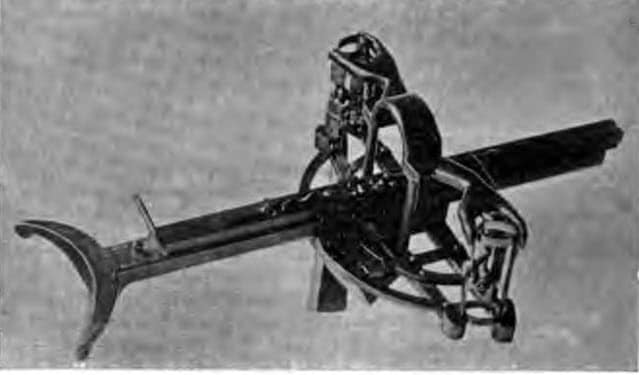
Source: Wikimedia Common
Whenever we think of the crossbow, we usually think of the late medieval version, which was a very different weapon to the sort of weapon that I’m going to describe now. But the Romans did have some weapons which resemble the crossbow very much. These were siege weapons such as the Scorpio and the ballista, but we do mention the so-called Manuballista.
It was a handheld version of the ballista, which was a giant crossbow. There is a lot of controversy about how these weapons were used and how effective they would be. The general idea is that a field version existed, which was a smaller version of the actual ballista, but at least two men used it, and again, it was a sort of weapon used during sieges.
We have stone carvings and pictorial evidence of small handheld crossbows like weapons used by people during the Roman empire. Still, the majority of this imagery comes from hunting scenarios. It looked similar to a handheld crossbow, but it wasn’t used for military purposes. The military version would be something akin to a siege weapon.
Furthermore, the model of a manuballista was expounded to make the Carroballista. It’s distinct feature lay in its maneuverability: it was made to carry field weapons.
7. Spatha

Source: Wikimedia Common
The Spatha was a type of sword employed by the Roman Empire. The advent of Celtic auxiliaries introduced the weapon to the Roman army. The Celtic was famous for using their slender blades. It was widely used on the battlefield and later replaced the Gladius, which was used for many centuries.
The Spatha was about 0.75 to 1 meters long. The handle was between 18 to 20 centimetres. It was because of this that it was useful for cavalry. Primarily used to slice the adversaries, it went on to occupy both, even the infantry. There were numerous reasons to use it, especially to reach farther by the legionaries. It established itself as the standard sword by the end of the fall of the Western Roman Empire.
It’s domination over both the infantry and cavalry led to its alteration of design. The Spatha carried by a cavalryman had a round tip while that of infantrymen had a pointed tip. The tapered tip increased the reachability, and the rounded tip ensured protection against accidental stabbing of their foot or horse. This alteration made it best suitable for each of the military men. Armed with such a deadly weapon, they were lethal.
Gradually, it evolved into the Medieval sword that we are aware of.
6. Onager
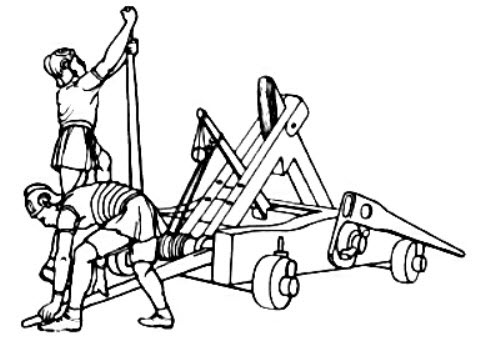
Source: Wikimedia Common
The Onager was a type of Roman catapult developed around 353 AD. It was named after its characteristic catapulting action it made when fired. Although it was not very portable, it was one of the most useful and practical siege weapons.
The design of the Onager was simple and played the substitute of the Roman ballista. The architect was wooden framed, which made it easier to operate. It required very few soldiers to work it, even less than those needed in a ballista. It is projected as having a bucket to hold the projectile. However, it might be a sling as the sling trajectory is far higher than a bucket.
The Onager would launch via a single torsion engine. It deployed its power from a load of twisted ropes, which were strong and elastic. They were often made of hair. A catapult engine was wound down, and the tension in the machine would then increase. Thus when let loose, the catapult arm would fling back at rapid speed. The catapult arm would hit a padded frame stopping the catapult arm but transferring the energy into the projectile, which was then sent flying through the air.
It vibrated with a lot of energy when launched. Hence, it didn’t have any wheels attached to avoid missing the target by a recoil.
5. Plumbatae
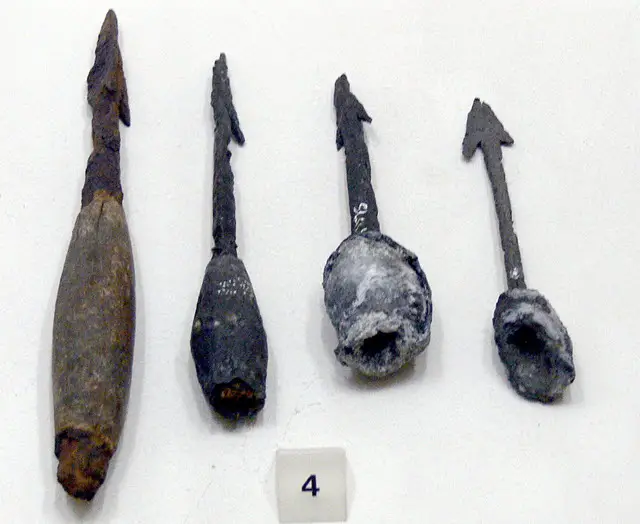
Source: Wikimedia Common
The Plumbatae were small, thin, handheld, and hand-thrown darts used by armies in antiquity. Named after the loaded javelins or martiobarbuli, they translate to little thorns of Mars. The thorns implied a barbed head, and Mars was the god of war.
Usually, when you think of the plumbata, you imagine the late Roman army, and rightly so. You could even say the Byzantine army, but also the Greeks used them. It was a weapon that was not only Roman, which is essential to underline. Vegetius, in his De re Militari, mentioned this weapon and praised it. He stated that every soldier carried five of these in the hollow of their shields.
A second source, also from the 4th century, is an anonymous treatise titled De Rebus Bellicis, which briefly discusses spiked plumbata, but which is also the only source that shows an image of what it looked like. It is more or less a short arrow with a weight attached to the shaft.
Plumbate etymologically contains plumbum (lead) and can be translated as ‘lead-weighted.’ Archeological testament gives it a clearer picture. It is consistent with Vegetius’ description.
4. Corvus

Source: Wikimedia Common
Corvus is the Latin word meaning crow. The probable ancient name should be harpago. It was a device used aboard a naval ship for naval warfare during the First Punic War while fighting against Carthage.
The device was a bridge of about 4 feet wide and 36 feet long, having a small parapet on both sides. The bridge was raised and lowered with the help of pulleys and a pole. The underside of the ship boasted a beak-like spike to puncture the enemy ship decks. It leveraged grip between two vessels and provided a route for the soldiers to cross over to the enemy ship.
Rome had not ventured to go on the sea in the third century BC. Since their military strength was on land, their most significant advantage was legionaries’ discipline and training. During the war against Carthaginians, the Corvus played a vital part in defending the adept naval soldiers. This tactic proved to be fruitful and helped win several battles. The most notable are those of Sulci, Tyndaris, Mylae, and Economus.
3. Pilum
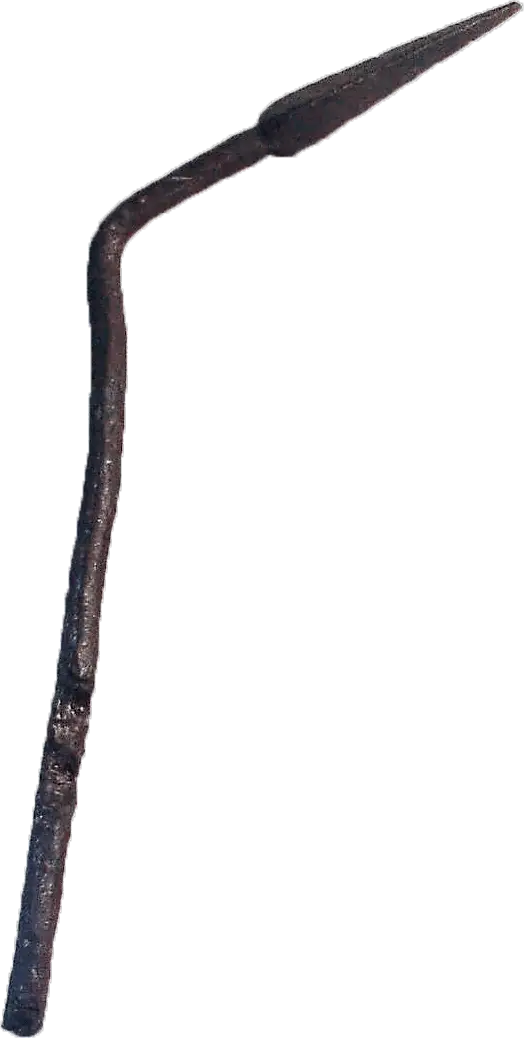
Source: Wikimedia Common
The pilum was a specialized and unique type of weapon. It was a throwing spear used in the Roman era consisting of a wooden shaft with a pointed iron shank joined together in various ways. A long iron shank characterizes the pilum, and a relatively small side pointed head at the end.
There is an academic debate over the purpose and origin of this very peculiar and characteristic design. The pilum was a more extensive and more massive type of weapon used in the Roman era by Roman soldiers than the lighter and shorter type of spear. While it was used for more extended range, the pilum was employed at much closer range by troops which were often better armed for close combat.
The pilum was of different kinds, including a socketed one. However, the common feature of all was the long iron shank. Besides that, the weight and length varied, which suggest that each had their purpose.
The pilum came into prominence during the Celtic invasions. Its weight gave excellent penetration, and the long metal shaft prevented its being cut away. The Romans used pila in the 3rd century BC. They increasingly relied on them, equipping each legionary with two pila (one more slender and lighter than the other).
2. Pugio

Source: Wikimedia Common
Pugio was a legionary dagger, which was not particularly attention-seeking but complemented the Gladius well. It comes from the word Pungo, which means to sting or pierce.
It wasn’t uniquely Roman, but rather it had been introduced to the Romans. They recognized it for its effectiveness. During the Second Punic War, in the latter part of the third century BC, Polybius gives a good description of the Roman infantry and its equipment.
Later, two authors, Casprini and Saliola, have penned a book on Pugio. They argue that the first finds of these occurred in 130-100 BC in Northern Spain. The Romans were coming up against the local tribes and Celts troops who were very well trained in close-quarter combat using daggers and shorter swords. The Romans used Pugio as a response to dire circumstances.
Gaius Marius, who developed the entire Roman military, served in Spain and was involved in Numantine wars. He chanced upon this weapon and brought it in when he reformed the army himself. They issued this stabbing weapon by both auxiliary and legionary soldiers. However, the light infantry and cavalry did not carry it.
It was a pugio that Brutus had used to stab Julius Caesar.
1. Gladius
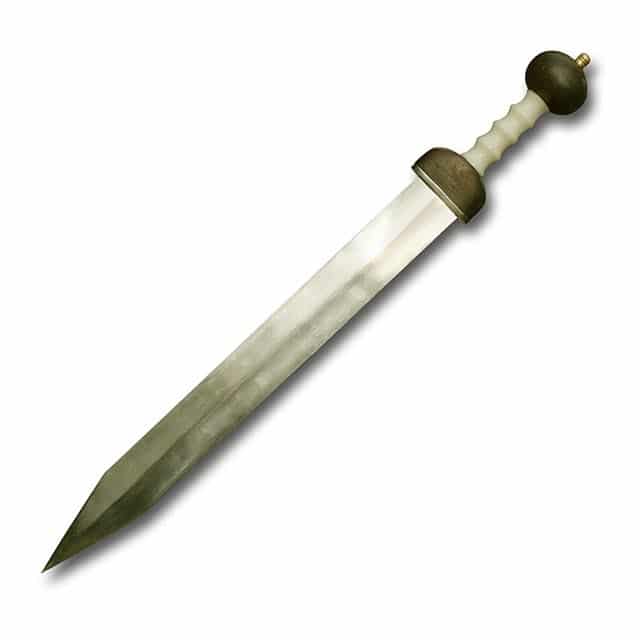
Source: Wikimedia Common
Gladius, the Roman short sword that conquered an Empire, is the Latin for a sword. Before the reforms of Gaius Marius, the Roman legions used a blade similar to the Greek xiphos. After that, they were equipped with a shield, javelins(pila), a dagger (Pugio), darts (Plumbatae), and a sword-Gladius.
It had two ends that cut and a tapering end for stabbing. A solid knobbed hilt provided for an unmatched grip with finger ridges. The hilt was usually ornately designed, especially for dignitaries. The blade strips were welded together, or single high-carbon steel was placed. It gave the blade a super strength for cutting. Often, the owner’s name was etched on edge. The intricately carved scabbard covered the sword, which was then adjusted to the belt or shoulder strap.
The standard infantry attack was on the stomach, but they were well trained to thrust the sword on kneecaps below the shields. But stabbing on the abdomen was most preferred and efficient. There were several types of Gladii. Three of the primary were the Mainz gladius, the Fulham gladius, and the Pompeii gladius. Most recent findings suggest another type called the gladius hispaniensis.
Even though it was a very popular sword, the end of the 2nd century AD saw a more evolved version of Gladius called the Spatha.
Related:
Conclusion
The Roman armors were instruments that were absorbed from enemy military technology. Any gaps that remained in their training were immediately compensated by their use of auxiliaries: the staple pugio, pila, and Gladius. While the weapons were only a component of their incredible equation in warfare, Roman legionaries were victorious in both land and water.
In percentage, the forces of Hannibal or the Barbarians lacked some of the advanced arms that the Romans boasted. At the same time, Imperial Rome’s forces were at war with fully equipped enemies. Either way, the Romans exuded meritocracy, military discipline, and ferocious training that made them formidable and sustained their legacy for centuries.
